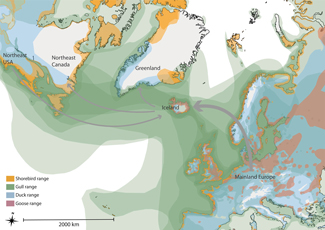Other articles of note from Fogarty’s Division of International Epidemiology and Population Studies
November/December 2023 | Volume 22 Number 6
 Image adapted from Figure 3 of the publication, "Exploring intercontinental movement of influenza among migrating aquatic birds," courtesy Jonathon D. Gass Jr., et al.A map showing migratory ranges for types of birds that are hosts for various influenza A viruses.
Full image and description can be found in the figure viewer on the Wiley Online Library.
Image adapted from Figure 3 of the publication, "Exploring intercontinental movement of influenza among migrating aquatic birds," courtesy Jonathon D. Gass Jr., et al.A map showing migratory ranges for types of birds that are hosts for various influenza A viruses.
Full image and description can be found in the figure viewer on the Wiley Online Library.
Influenza studies
Exploring intercontinental movement of influenza among migrating aquatic birds
Dr. Nídia Trovão co-authored this paper exploring intercontinental movement and reassortment of influenza A viruses (IAV) circulating among aquatic birds that migrate to breeding zones in the Arctic and sub-Arctic. Between May 2010 and February 2018, the team obtained isolates from various species of seabirds, shorebirds and waterfowl plus samplings of avian fecal material from locations throughout Iceland, which connects the east and north Atlantic flyways. Trovão and her co-authors stated in Molecular Ecology, “Gulls play an outsized role as sinks of influenza A viruses from other avian hosts prior to onward migration."
Looking at global data to define factors that lead to severe influenza-related hospitalizations
The Journal of Infectious Diseases published this study based on data from the Global Influenza Hospital Surveillance Network (GIHSN). Among 73,121 patients in 22 countries hospitalized with respiratory illness (15,660 had lab-confirmed flu), a seven-fold increase in the risk of flu-related ICU admission was seen in lower middle-income countries (LMICs) compared with high-income countries, according to Dr. Cécile Viboud and colleagues. The risk of mechanical ventilation and in-hospital death also increased four-fold in LMICs, though these differences were not statistically significant. Deaths due to flu increased significantly with older age and number of comorbid conditions; influenza A/H1N1pdm09 was more severe than A/H3N2.
The global toll of flu: An estimate of flu-associated hospitalizations in 40 countries
Flu is common worldwide, yet information regarding its severity remains limited. The researchers used a logit-logistic regression model, a type of statistical technique for obtaining pooled estimates across multiple studies with different types of data, in their analysis of 127 recent studies estimating hospitalizations with flu. Overall, pooled flu-associated hospitalization rate was 40.5 per 100,000 persons, with rates varying substantially by age: 224.0 in young children (ages 0 to 4) and 96.8 in the elderly (ages 65 and older). National hospitalization rates (all ages) varied considerably, ranging from just 11.7 per 100,000 in New Zealand to 122.1 per 100,000 in India. Dr. Cécile Viboud and her co-authors of this Journal of Global Health study estimate seasonal flu epidemics result in 3.2 million hospitalizations each year.
Studies from the Household Air Pollution Intervention Network (HAPIN) trial
Measuring adherence to clean cooking fuel use during the Household Air Pollution Intervention Network (HAPIN) trial
Reducing household air pollution requires nearly exclusive use of clean cooking fuels. HAPIN trial participants—pregnant women in Guatemala, India, Peru, and Rwanda—either received a liquefied petroleum gas (LPG) stove intervention (1,590 women) or continued cooking with traditional stoves (1,605). The intervention included a free stove, unlimited supply of LPG fuel delivered to the home, repairs, and behavioral messaging. In intervention households, traditional stoves were used a median of 0.4% of all monitored days; pre- and post-birth data showed no significant differences in adherence. Fogarty's Dr. Joshua Rosenthal co-authored this study, published in Environment International.
- Publication:
Environment International
 Photo courtesy Peace CorpsTwo large black pots used for cooking over a wood fire in Eswatini.
Photo courtesy Peace CorpsTwo large black pots used for cooking over a wood fire in Eswatini.
Evaluating the effect of clean cooking on maternal outcomes
About 2.3 million premature global deaths can be attributed to household air pollution each year. A second HAPIN study in Environment International evaluated the effects of an LPG stove intervention (as described above) during pregnancy on spontaneous abortion, postpartum hemorrhage, hypertensive disorders of pregnancy, and maternal mortality. Among the participants, 10 experienced spontaneous abortions (seven intervention arm, three control arm), 93 hypertensive disorders (47 intervention, 46 control), 11 post-postpartum hemorrhage (five intervention, six control) and four died (three intervention, one control). Relative risk (compared to controls) for a spontaneous abortion among women in the intervention arm was 2.32, hypertensive disorder 1.02, postpartum hemorrhage 0.83 and maternal mortality 2.98, noted Dr. Joshua Rosenthal and his co-authors.
Examining the relationship between household air pollution exposures and birthweight
A third HAPIN study appeared in The Lancet, Planetary Health. Dr. Joshua Rosenthal and colleagues examined associations between household air pollution exposures and birthweight. Of 3,002 births, 163 (5.3%) were classified as preterm (average gestational age at delivery was 39.3 weeks) and 531 (17.7%) as low birthweight; mean birthweight was 2,921 g in the intervention group and 2,898 g in the control group, a difference of 23 g. An interquartile (from 25th to 75th percentile) increase in gestational exposure for fine particulate matter (PM2.5; 74·5 μg/m3) was associated with a change in birthweight of minus14.8 grams; for black carbon it was minus 21.9 grams.
Studies on other topics
Exploring hotspots of mutation in bacterial genomes
Dr. Joshua Cherry published this exploration of bacterial mutation in Genome Biology and Evolution. The rate of mutation is known to vary across genome position, yet local sequence context can affect this rate, he notes. Preceding runs of three or more G residues greatly increase the rate of T→G mutation. The strength of this effect increases with the length of the run, a phenomenon observed in all bacteria analyzed yet strongest in
Salmonella (and nearly as strong in
E. coli). In
Salmonella, a G run of length three increases the mutation rate by a factor of (approximately) 26, a run of length four increases it by a factor of (approximately) 100, while runs of five or more increase it by a factor of more than 400 (on average). This effect is much stronger when the T is on the leading rather than the lagging strand of DNA replication.
Developing a more efficient approach to reconstructing trait evolution
Scientists gain insights into underlying biological processes when they identify how the features of specimens that have evolved together relate to and influence one another. Yet it is computationally challenging to compare traits across many specimens. Co-authors Dr. Nídia Trovão, Dr. Joshua Cherry, and colleagues developed a more efficient approach to this problem than the bouncy particle sampler (BPS) methodology, the current state-of-the-art technique. Their approach, as applied to the study of the evolution of HIV and flu viruses as well as to flower and pollinator co-evolution, largely outperformed BPS, while reducing runtimes five-fold. Their work is published in PLoS Computational Biology.
A method for focusing DNA sequencing on bacteria of interest
Fogarty's Dr. Joshua Cherry co-authored this paper published in Applied and Environmental Microbiology. Matching contaminated food to its agricultural source can prevent further illness without disrupting (clean) supply chains. When trying to trace an outbreak source, metagenomic sequencing may be insufficiently sensitive. The authors describe and implement REMoDE, an approach that enriches DNA samples from organisms-of-interest. REMoDE works particularly well for many members of the Gammaproteobacteria phyla (including E. coli and
Salmonella). “In our experiments, we observe enrichment of
E. coli and
Salmonella DNA ranging from 11-fold to 142-fold," noted the authors. They also commented that enrichment can be performed in a single tube and completed within 1.5 hours.
Aggregating predictions to make better public health decisions
During infectious disease emergencies, the public health decision-making process seeks to identify what could happen and the likelihood of potential outcomes. Compared to a single model, aggregated predictions from multiple models can capture future outcomes more accurately and reliably. A key challenge, then, is identifying which aggregation method provides the most appropriate expression of uncertainty, noted Dr. Cécile Viboud and her co-authors who examined two common aggregation approaches—linear opinion pool (LOP) and Vincent average methods. “Inappropriately aggregating with LOP will overestimate the probability of extreme events and may suggest more drastic actions than necessary. Conversely, inappropriately using the Vincent average may underestimate these probabilities, leaving decision makers unprepared," the authors concluded in The Journal of the Royal Society Interface.
- Publication: The Journal of the Royal Society Interface
Updated December 11, 2023
To view Adobe PDF files,
download current, free accessible plug-ins from Adobe's website.
Related Global Health Research Topics